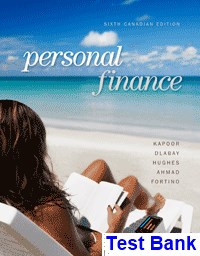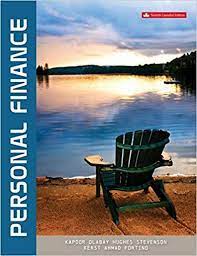Description
Test Bank For Personal Finance 6th Canadian Edition by Jack Kapoor
03
Student: _______________________________________________________________________________________
1. The main purpose of taxes is to
A. create jobs
B. reduce the chances of inflation.
C. generate revenue for funding government programs. D. discourage use of certain goods and services.
E. decrease competition from foreign companies.
2. The use of legitimate methods to reduce one’s taxes is tax ____________.
A. evasion
B. avoidance
C. exemptions
D. deferred techniques E. reductions
3. The ______________ property tax is based on the value of land and buildings.
A. personal
B. real estate C. direct
D. proportional E. regressive
4. An exemption affects a person’s tax situation by:
A. increasing the standard deduction.
B. increasing the taxpayer’s marginal tax rate. C. decreasing itemized deductions.
D. reducing the taxpayer’s taxable income.
E. increasing taxexempt income.
5. Taxable income is used to compute a person’s
A. exemptions. B. income tax. C. deductions. D. tax credit. E. exclusions.
6. Which of the following would result in a reduction of taxable income?
A. portfolio income B. tax credits
C. union dues
D. business income E. earned income
7. Money received by an individual for personal effort is ____________ income.
A. earned or employment investment B. investment
C. portfolio
D. excluded
E. capital gains
8. Money received in the form of dividends or interest is ____________ income.
A. business income
B. earned or employment C. excluded
D. capital gain
E. investment
9. Earnings from a limited partnership would be an example of ____________ income.
A. earned
B. investment
C. portfolio
D. net business income E. excluded
10. Income that is not subject to income tax includes:
A. B. C. D. E.
the GST/HST rebate.
the Canada child tax benefit
gifts.
lottery winnings.
GST/HST rebates, Canada Child Tax benefits, gifts, and lottery winnings are not subject to income tax.
11. Which of the following would be excluded from total income to obtain net income?
A. contributions to RPPs
B. mortgage interest
C. child support payments D. foreign income exclusion E. charitable contributions
12. Phillip Marnier had earnings from his salary of $40,000, interest on savings of $700, and a contribution to a registered retirement saving plan of $1,500. Phillip’s net income would be
A. $39,200. B. $40,000. C. $39,300. D. $38,500. E. $41,500.
13. Jack sold $20,000 worth of stocks that were purchased one year ago for $15,000. He is in a 22% tax bracket. Jack’s capital gains taxes are:
A. $500. B. $550. C. $1,100. D. $2,500. E. $4,400.
14. Reductions from gross income for such items as registered retirement account contributions and RESP payments will result in
A. business income B. taxable income. C. earned income. D. net income.
E. total exclusions.
15. Winning the lottery affects a person’s tax situation by
A. increasing the standard deduction.
B. increasing the taxpayer’s marginal tax rate. C. decreasing itemized deductions.
D. increasing taxexempt income.
E. having no influence at all on taxable income.
16. Which of the following is a standard tax credit?
A. itemized deductions
B. withholding
C. an earned tax credit
D. the basic personal amount E. capital gains
17. ____________ are expenses that a taxpayer is allowed to deduct from total income.
A. Exemptions
B. Exclusions
C. Deductions
D. Tax credits
E. Passive income
18. An expense that would be included in the deductions of a taxpayer is
A. travel to work.
B. life insurance premiums.
C. union and professional dues. D. a driver’s license fee.
E. tuition fees.
19. The basic personal amount is
A. the standard deduction. B. a tax credit.
C. an itemized deduction. D. an exclusion.
E. an exemption.
20. A tax ____________ is an amount subtracted directly from the amount of taxes owed.
A. credit
B. exemption C. deduction D. exclusion E. shelter
21. Which of the following is an example of a tax credit?
A. mortgage interest
B. amounts withheld for social insurance
C. individual retirement account contributions D. caregiver and medical expenses
E. net business income
22. A tax credit of $50 for a person in a 28 percent tax bracket would reduce a person’s taxes by
A. $10. B. $28. C. $14. D. $50. E. $35.
23. Most people pay federal income tax by
A. paying the total amount owed by April 15. B. filing quarterly tax payments.
C. having amounts withheld from source.
D. earning tax credits for various deductions. E. cashing in their saving.
24. Estimated quarterly tax installments must be made by those who
A. are employed in a foreign country.
B. receive dividends.
C. work for the government.
D. owe yearend taxes of over $2,000 for both the current year and either of the two preceding y years. E. have been caught committing fraud.
25. Which of the following people is least likely to have to file a federal income tax return?
A. a person earning $8,750
B. a person earning $10, 750
C. a person earning less than $9,600 D. a person over age 65
E. a college student
26. A person with a total tax liability of $4,350 and withholding of federal taxes of $3,975 would:
A. receive a refund of $4,550. B. owe $8,325.
C. owe $375.
D. receive a refund of $8,325. E. receive a refund of $375.
27. The financial planning objective is to:
A. evade taxes.
B. minimize taxes.
C. maximize income.
D. maximize aftertax cash flows. E. maximize tax credits.
28. Jennifer made $2,000 worth of charitable donations. Her total income is $36,000 and she is in the 22% federal tax bracket. What is her charitable donations tax credit?
A. $320 B. $440 C. $552 D. $2,000 E. $5,760
29. Which type of tax expert would be of most value when you have a difference of opinion with the tax department?
A. an enrolled agent
B. a nationallychartered tax preparer C. aCA
D. a tax accountant
E. a tax attorney





Be the first to review “Test Bank For Personal Finance 6th Canadian Edition by Jack Kapoor”